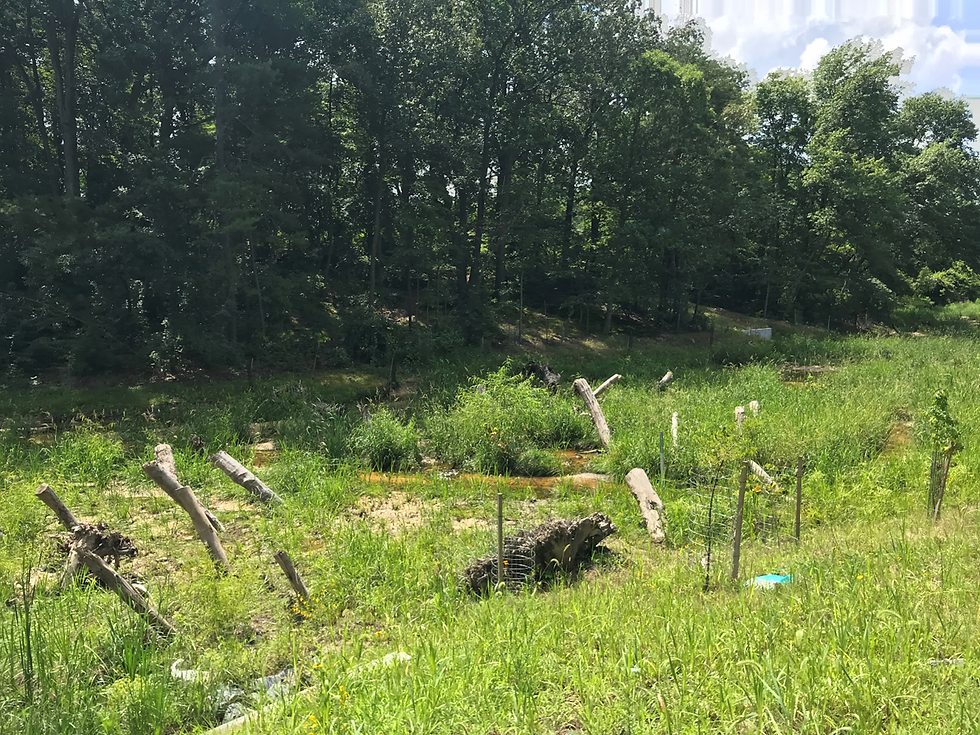Furnace Creek Stream Restoration, Unique Urban Challenges in Anne Arundel County, MD
- Watershed Moments
- Oct 9, 2020
- 4 min read
By Luke Feight, Superintendent and Mark Chirdon, Project Foreperson
The stream restoration at Furnace Creek in Glen Burnie was a very challenging project for everyone involved. Upon our arrival, the stream consisted of a concrete lined channel that extended for about 3200 linear feet with a large scour hole at the downstream extent of the concrete. In addition, there was about 1500 linear feet of “natural channel” downstream of the concrete that was unraveling due to the velocity of the water coming off the channel, especially during heavy rains. Our scope of work revolved around the removal of about half of the concrete (and filling on top of the other half) and creating a meandering base flow channel with a wide floodplain in order to reduce the shear stress of flows traveling through the system, especially during storm events. This would effectively reduce erosive forces and limit the movement of sediment downstream.

EQR’s construction began at the large box culvert at the upstream end of the project, where we removed the wing walls of the existing culvert and replaced them with imbricated walls. From there, EQR constructed a large riprap scour basin to aid in the dissipation of heavy flows when they entered the system. Downstream of the basin, is where we really began to expand the floodplain width and install the base flow channel. Our crews installed countless log sill structures, some of which extended across the entire floodplain, as well as clay barriers and several manhole/outlet structures that connected to the existing storm water conveyance assets that were scattered throughout the site. There were also several sections of the stream, mainly where the floodplain needed to be pinched due to property lines or existing topography, where we installed a stone layer consisting of Class 0 rip rap. This aided in the stability of these sections, as we did not have the luxury of enough space for a wider floodplain, unlike several other areas of the project site. All the woody debris that was accumulated on site was placed in the floodplain to create roughness and further dissipate the velocity during flood events, as well as to provide habitat for insects and aquatic creatures.

Another of the logistical challenges was the fill balance across the site. The design goal was to have minimal net change in terms of import/export. However, this meant the upstream portion of the site with the concrete channel was required the dirt to be removed and that downstream natural areas required fill. This is one of the reasons we utilized two crews on opposite sides of the site to expedite this process. Given a one lane access road and limited space, we were able to navigate the challenges and keep two crews moving productively.

Our challenges also centered around the saturation of the site, especially as a large part of this project was done during a time where our region experienced more precipitation than ever. As we pulled up sections of concrete, the conditions underneath was variable, and at times were extremely sloppy. In my opinion, (Luke Feight) it seemed as though the concrete trapped water behind it over the years, and the corresponding soils were extremely wet as a result. This was unanticipated but we figured out strategies to work through it, nonetheless. The downstream “natural channel” section consisted of mostly fill that had to be imported to the site. This process took some time, but in all, we were able to fill in a 7-foot-deep channel, which was about 20 feet wide, and match it to the features we were creating upstream. This obviously led to some muddy conditions, but we worked diligently on compacting the soils to maintain the integrity of the work as the vegetation tried to establish. The vegetation itself was a challenging task too, as the frequency of the storms we experienced during construction were not conducive to keeping the seed in place. However, we kept at it and eventually we got things to take off throughout the site.

At the end of the day, EQR is extremely proud to have been part of a project such as this, as we were able to remove a concrete channel, rehabilitate the unraveling natural section and create a healthier system that was more likely to benefit the surrounding ecosystem. When we first arrived on site, there was very little aquatic life, as there was no habitat, but now there is a diverse population of frogs, small fish, ducks, swans, dragonflies, and other wetland creatures that have established themselves in our completed work. It is a very satisfying to witness the return of these animals and insects, and hopefully, as our work further settles in, their populations will continue to grow as the ecosystem becomes healthier. The contrast from when we started construction to the condition the site is in now is truly astounding and is a perfect example of why EQR works hard to continue rehabilitating our natural spaces.
“Furnace Branch was one of the most difficult projects that I have been a part of in my time at EQR. Looking at the pre and post construction photos tells me all I need to know; the stream and surrounding habitat is much healthier than it was prior to our work,” Mark Chirdon.









Comments